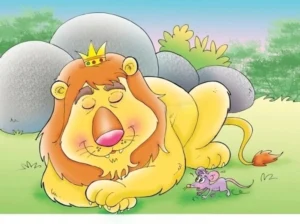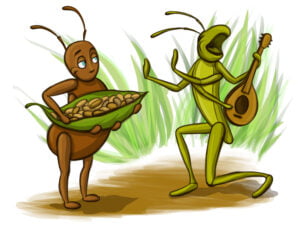Panchatantra Stories are a collection of ancient Indian fables, believed to have been written around 200 BCE by Vishnu Sharma. The tales have been translated into many languages and are popular all over the world for their moral lessons and timeless storytelling.

The Lion and the Mouse – Story with Moral
The Lion and the Mouse Story : Part 1: The King and the Humble Nibbler In a vast kingdom of golden grasslands and shimmering acacia trees, there reigned a mighty Lion. With

The Fox and the Grapes : Aesop’s Fables
The Fox and the Grapes: Once upon a time, in a big, green forest, there lived a clever fox named Rusty. Rusty was always looking for a tasty snack, and his tummy

The Thirsty Crow and the Pitcher Story for Kids
The Thirsty Crow and the Pitcher The Crow’s Big Thirst The sun beat down on the crow’s black feathers like a giant bonfire. He’d been flying all morning, his tongue feeling thick

The Ant and the Grasshopper: A Lesson in Preparedness
Story The Ant and the Grasshopper: Once upon a time, in a sunny meadow filled with buzzing bees and fluttering butterflies, there lived a hardworking little ant named Anthony. Anthony wasn’t the
The Ancient Roots and Enduring Appeal of Panchatantra Stories
The Panchatantra, meaning “Five Principles” or “Five Treatises,” is a collection of animal fables that originated in ancient India. Believed to be compiled by the wise scholar Vishnu Sharma around 200 BCE, these stories have traversed continents and cultures, becoming an integral part of global storytelling traditions.
The Panchatantra is not merely a collection of children’s tales; it is a repository of practical wisdom, ethical guidance, and profound insights into human nature. The stories, though simple on the surface, often delve into complex themes such as friendship, loyalty, greed, deception, and the consequences of one’s actions.
Why Panchatantra Stories Endure:
- Universality of Themes: The stories deal with timeless themes that resonate with people of all ages and backgrounds. They explore fundamental human emotions, motivations, and conflicts, making them relevant across centuries and cultures.
- Engaging Narrative Style: The tales are characterized by their captivating narrative style, often featuring anthropomorphic animals as protagonists. These animal characters, with their distinct personalities and quirks, make the stories relatable and entertaining.
- Didactic Value: Each story concludes with a moral lesson, gently guiding readers towards understanding important life principles and ethical values. The Panchatantra is not preachy but subtly encourages critical thinking and moral reasoning.
- Cultural Significance: The stories offer a glimpse into ancient Indian culture, its societal norms, and its philosophical underpinnings. They provide insights into the values and beliefs that shaped the civilization.
The Five Treatises (Pancha-tantra):
The Panchatantra is divided into five books or treatises, each focusing on a specific theme:
Mitra-bheda (The Loss of Friends): This section explores the dynamics of friendship and the factors that can lead to its dissolution. It highlights the importance of trust, loyalty, and understanding in maintaining healthy relationships.
Mitra-lābha (The Winning of Friends): This part focuses on the importance of forming alliances and friendships. It illustrates how collaboration and mutual support can lead to success and overcome challenges.
Kākolūkīyam (Crows and Owls): This treatise delves into the themes of war and conflict. It examines the causes and consequences of enmity and emphasizes the importance of diplomacy and strategic thinking.
Labdhapraṇāśam (Loss of Gains): This section explores the theme of loss and misfortune. It teaches the importance of perseverance, resilience, and the ability to adapt to changing circumstances.
Aparīkṣitakārakaṃ (Ill-Considered Action): This part cautions against impulsive actions and hasty decisions. It emphasizes the importance of careful planning, thoughtful consideration, and seeking counsel before taking action.
The Panchatantra's Global Influence:
The Panchatantra’s influence extends far beyond India. Its stories have been translated into numerous languages and have inspired countless fables and folktales around the world. The tales of Aesop, for instance, share many similarities with the Panchatantra stories, suggesting a possible connection or shared source of inspiration.
The Panchatantra’s enduring appeal lies in its ability to entertain, educate, and inspire. Its stories continue to resonate with readers of all ages, offering valuable life lessons and a deeper understanding of human nature.
Panchatantra Stories for Kids: Nurturing Young Minds with Timeless Wisdom
Panchatantra stories are an invaluable resource for parents, educators, and anyone who interacts with children. These tales, with their engaging characters and simple yet profound morals, offer a unique way to impart valuable life lessons and foster a child’s intellectual and emotional growth.
Why Panchatantra Stories Resonate with Children:
Animal Protagonists: Children are naturally drawn to animals, and the Panchatantra’s anthropomorphic characters – talking lions, clever monkeys, wise tortoises – spark their imagination and curiosity. These characters become relatable figures through which children can explore different aspects of human behavior.
Exciting Adventures: Many Panchatantra stories are filled with adventure and suspense. Whether it’s a monkey outsmarting a crocodile or a clever rabbit tricking a lion, the narratives keep children engaged and eager to discover what happens next.
Relatable Situations: The stories often depict scenarios that children can relate to, such as sibling rivalry, peer pressure, or the struggle to make wise choices. This relatability allows children to connect with the characters and learn from their experiences.
Gentle Moral Guidance: The moral lessons in Panchatantra stories are presented in a gentle and non-preachy manner. Children are not explicitly told what to do but are encouraged to reflect on the consequences of different actions and arrive at their own conclusions.
Popular Panchatantra Stories for Kids:
Here are a few of the most beloved Panchatantra stories that have captivated children for generations:
The Tortoise and the Hare: This classic tale teaches the importance of perseverance, consistency, and not underestimating one’s abilities. The slow and steady tortoise wins the race against the boastful hare, reminding us that even with limited resources, we can achieve our goals through determination and effort.
The Monkey and the Crocodile: This story cautions against greed and treachery. A friendship between a monkey and a crocodile is tested when the crocodile’s wife demands the monkey’s heart. The monkey cleverly outsmarts the crocodile, highlighting the importance of quick thinking and resourcefulness.
The Blue Jackal: A jackal falls into a vat of indigo dye and uses his transformed appearance to become the king of the forest. This tale explores themes of deception and the fleeting nature of power gained through dishonest means. It also emphasizes the importance of authenticity and self-acceptance.
The Musical Donkey: A washerman’s donkey, attempting to mimic a jackal’s howl, causes chaos in a village. This humorous story teaches us to embrace our own unique talents and not try to be someone we’re not.
The Brahmin and the Mongoose: A devoted mongoose protects a baby from a snake but is mistakenly killed by the mother who believes it has harmed her child. This poignant story emphasizes the importance of careful observation and not jumping to conclusions based on appearances.
Tips for Sharing Panchatantra Stories with Children:
- Choose Age-Appropriate Stories: Select stories that align with your child’s age and developmental stage. Younger children might enjoy simpler tales with repetitive elements, while older children might appreciate more complex narratives.
- Make it Interactive: Encourage your child to participate in the storytelling process. Ask questions, invite them to predict what might happen next, and discuss the moral lessons together.
- Use Visual Aids: Illustrations or puppets can enhance the storytelling experience and capture your child’s attention. You can also find animated versions of Panchatantra stories online.
- Connect to Real-Life Situations: Relate the stories to real-life situations that your child might encounter. This helps them understand how the moral lessons apply to their own lives.
- Read Regularly: Make reading Panchatantra stories a regular part of your routine. This not only fosters a love of reading but also reinforces the values and lessons embedded in the tales.
Unearthing Hidden Gems: Lesser-Known Panchatantra Stories
While classics like “The Tortoise and the Hare” and “The Monkey and the Crocodile” have earned their well-deserved fame, the Panchatantra is brimming with lesser-known stories that offer equally valuable lessons and delightful narratives. Let’s delve into a few of these hidden gems:
The Four Friends (The Deer, the Crow, the Mouse, and the Tortoise): This heartwarming tale emphasizes the power of friendship and cooperation. A deer, crow, mouse, and tortoise, each with unique abilities, work together to save one another from various perils. The story demonstrates how collaboration can overcome even the most challenging obstacles.
The Brahmin and the Goat: A greedy Brahmin dreams of using his pet goat to attract a large gathering of followers. However, his cunning plan backfires, and he loses both the goat and his reputation. This story serves as a cautionary tale against greed and the dangers of manipulative behavior.
The Lion, the Jackal, and the Donkey: A lion, a jackal, and a donkey form an unlikely alliance to hunt for food. However, their differing personalities and motivations lead to conflict and eventually, the demise of the donkey. This story explores the dynamics of power, trust, and the importance of choosing allies wisely.
The Clever Pigeon: A flock of pigeons is trapped in a hunter’s net, but a wise pigeon devises a plan to free them all. By working together and following the pigeon’s instructions, they manage to escape. This story highlights the importance of teamwork, quick thinking, and the power of a collective effort.
The Ungrateful Man: A man is saved from drowning by a tree spirit who asks for nothing in return. However, the man later betrays the spirit’s trust, leading to his downfall. This tale emphasizes the importance of gratitude, loyalty, and the consequences of ingratitude.
Using Panchatantra Stories in Education and Learning:
Panchatantra stories offer a wealth of educational opportunities for children and adults alike. Here are a few ways these stories can be used as effective tools for teaching and learning:
Classroom Discussions: Teachers can use the stories to spark discussions about moral values, ethics, and social issues. Students can analyze the characters’ choices, debate the outcomes, and apply the lessons to real-life situations.
Creative Writing Prompts: The stories can inspire children to write their own fables or narratives. They can create new characters, scenarios, and moral lessons, fostering their creativity and storytelling skills.
Role-Playing Activities: Students can act out the stories, taking on the roles of different characters. This immersive approach helps them understand the characters’ motivations, perspectives, and emotions.
Moral Reasoning Exercises: Teachers can present ethical dilemmas inspired by the stories and ask students to analyze them from different viewpoints. This encourages critical thinking and develops their ability to make ethical judgments.
Character Education: The stories can be used to teach character traits like honesty, kindness, compassion, and responsibility. By discussing the actions and consequences of the characters, students can learn to cultivate positive values.
Vishnu Sharma: The Master Weaver of Timeless Tales
While the Panchatantra stories themselves are the stars of the show, the figure behind their compilation, Vishnu Sharma, deserves recognition for his extraordinary contribution to literature and education. A scholar, teacher, and master storyteller, Vishnu Sharma is credited with weaving together these ancient fables into a cohesive and impactful narrative.
The Legend of Vishnu Sharma:
According to tradition, Vishnu Sharma was tasked with educating three dull-witted princes. Recognizing the challenge of imparting wisdom to these uninterested royals, Vishnu Sharma devised a unique approach. He crafted a series of engaging animal stories, each embedded with a moral lesson. Through these captivating tales, he managed to capture the princes’ attention and instill in them valuable life skills and ethical principles.
Whether this story is entirely factual or embellished over time is uncertain. However, it speaks volumes about Vishnu Sharma’s ingenuity and his understanding of the power of storytelling as a teaching tool.
Vishnu Sharma's Legacy:
Vishnu Sharma’s compilation of the Panchatantra has left an indelible mark on world literature. The stories he collected and organized have transcended time and cultural boundaries, inspiring countless writers, poets, and artists across the globe.
The Panchatantra’s influence can be seen in diverse literary works, from the fables of Aesop to the tales of the Arabian Nights. Its characters and themes have been reinterpreted and adapted in various cultural contexts, demonstrating the universality of its messages.
Beyond its literary impact, the Panchatantra has also played a significant role in education. For centuries, the stories have been used to teach children about values, ethics, and social skills. They continue to be a valuable resource in schools and homes, providing a fun and engaging way to learn about important life lessons.
The Timeless Relevance of the Panchatantra:
Even in today’s fast-paced and technology-driven world, the Panchatantra remains as relevant as ever. The challenges and dilemmas faced by the characters in the stories mirror the complexities of human relationships and the moral choices we encounter in our own lives.
The Panchatantra reminds us of the enduring power of storytelling to connect, inspire, and educate. Its timeless wisdom continues to guide us, offering insights into human nature, ethical behavior, and the pursuit of a meaningful life.
The Panchatantra's Timeless Legacy: Inspiring and Enriching Lives Worldwide
The Panchatantra is not merely a relic of the past but a living testament to the enduring power of storytelling. Its tales continue to resonate with people of all ages and cultures, offering guidance, wisdom, and a deeper understanding of human nature.
Preserving and Sharing the Panchatantra:
Efforts are underway to ensure that the Panchatantra’s rich legacy is preserved for future generations. Scholars, translators, and educators are working tirelessly to make these stories accessible to a wider audience. The tales have been translated into numerous languages, ensuring that their wisdom reaches diverse communities around the world.
Digital platforms have played a crucial role in expanding the reach of the Panchatantra. Online libraries, educational websites, and multimedia platforms offer a vast array of resources, including illustrated stories, animated videos, and interactive learning tools. This digital accessibility makes the Panchatantra readily available to children and adults alike, regardless of their location or background.
The Panchatantra's Impact on Modern Culture:
The influence of the Panchatantra can be seen in various aspects of modern culture, from literature and film to art and music. Many contemporary stories, cartoons, and even video games draw inspiration from its characters, themes, and narrative techniques.
The Panchatantra’s emphasis on moral values and ethical behavior resonates deeply with today’s society. Its stories serve as reminders of the importance of compassion, integrity, and social responsibility. They offer guidance on navigating complex relationships, making sound decisions, and leading a fulfilling life.
The Panchatantra and Personal Growth:
Reading or listening to Panchatantra stories can be a transformative experience. The tales encourage self-reflection and introspection, prompting us to examine our own beliefs, values, and behaviors.
By identifying with the characters and their struggles, we can gain valuable insights into our own strengths and weaknesses. The moral lessons embedded in the stories can serve as a compass, guiding us towards making wiser choices and fostering positive relationships.
The Panchatantra's Message of Hope:
At its core, the Panchatantra is a message of hope and optimism. It reminds us that even in the face of adversity, we have the power to overcome challenges, learn from our mistakes, and create a better future for ourselves and others.
The stories celebrate the triumph of good over evil, the importance of friendship and cooperation, and the enduring power of wisdom and knowledge. They remind us that we are all connected, and our actions have ripple effects on the world around us.
Conclusion: A Timeless Treasure for All Generations
The Panchatantra is a gift that keeps on giving. Its stories are a testament to the enduring power of human creativity, wisdom, and the desire to share knowledge across generations.
Whether you’re a parent seeking to instill valuable life lessons in your children, an educator looking for engaging teaching materials, or simply someone who enjoys a good story, the Panchatantra has something to offer.
So, take a moment to immerse yourself in the enchanting world of the Panchatantra. Let its timeless wisdom guide you, entertain you, and inspire you to lead a more meaningful and fulfilling life.
- The Monkey and the Crocodile
- The Lion and the Mouse
- The Fox and the Grapes
- The Tortoise and the Hare
- The Crow and the Pitcher
- The Ant and the Grasshopper
- The Brahmin and the Goat
- The Clever Rabbit and the Foolish Lion
- The Lion and the Jackal
- The Elephant and the Sparrow
- The Cat, the Rat, and the Hunter
- The Stork and the Crab
- The Monkey and the Wedge
- The Mouse and the Bull
- The Bear and the Two Travelers
- The Crow and the Snake
- The Mice and the Elephants
- The Old Man and his Sons
- The Lion, the Camel, the Jackal, and the Crow
- The Hermit and the Mouse
These stories are not only entertaining but also teach important moral lessons to children.